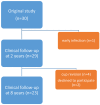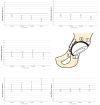Continuous periprosthetic bone loss around the TOP® cup and inferior survival rate at an 8-year follow-up: a prospective cohort study
- PMID: 39285412
- PMCID: PMC11403771
- DOI: 10.1186/s12891-024-07865-5
Continuous periprosthetic bone loss around the TOP® cup and inferior survival rate at an 8-year follow-up: a prospective cohort study
Abstract
Background: The trabeculae-oriented pattern (TOP®) cup was designed to minimize acetabular periprosthetic bone loss. In our previous prospective study comprising 30 patients with a two-year follow-up we found a substantial decrease in periprosthetic bone mineral density (pBMD) in the proximal and medial regions of the TOP cup. The present study aims to investigate pBMD changes in the mid-term and how this affects implant survival.
Methods: We followed the previous cohort and estimated implant survival by Kaplan-Meier analysis, evaluated pBMD with dual-energy X-ray absorptiometry (DXA) and clinical outcome using the Harris Hip Score (HHS).
Results: Mean follow-up was 8.6 (range 7.8-9.1) years. The eight-year implant survival rate for cup revision for all reasons was 83% (95% confidence interval {CI}: 70-97) and 86% (CI: 74-99) when cup revision due to aseptic loosening was the endpoint. Mean HHS at eight years was 95 (range 77-100). A further 12% (CI: 5-17) loss in pBMD was detected in the proximal Digas zone 1 and 12% (CI: 7-17) loss in Digas zone 2 also between two and eight years after surgery. pBMD continued to decrease up to 30% (CI: 24-36) in Digas zones 1, 2 and 3 compared to pBMD immediately postoperatively.
Conclusions: The TOP cup shows inferior mid-term survival rates compared to other uncemented cups, as well as a continuous decrease in pBMD. Periprosthetic bone loss cannot be prevented by this uncemented cup.
Clinical trial number: Not applicable.
Keywords: Cup; DXA; Prospective study; TOP cup; Uncemented THA.
© 2024. The Author(s).
Conflict of interest statement
NPH has received institutional grants and personal fees as lecturer from Waldemar Link GmbH, Heraeus, and Zimmer Biomet. SL has received institutional grants as lecturer from Waldemar Link GmbH and Heraeus. The other authors reported no conflicts of interest related to the study.
Figures




References
MeSH terms
LinkOut - more resources
Full Text Sources
Medical

